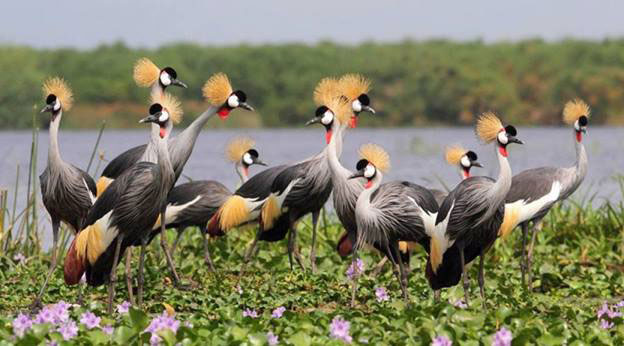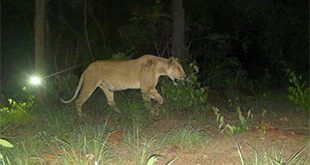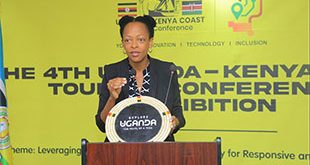
Kampala, Uganda | THE INDEPENDENT | This is a list of the bird species recorded in Uganda by Uganda Tourism Center (UTC), a leading independent tourism and holiday resource center responsible for marketing Uganda worldwide. Uganda has a total 1061 species of birds.
This list has been designed in sequence of orders, families, and species and we have listed them in common and scientific names.
Ostriches ( Ostrich Struthio camelus)
The Ostrich is a flightless bird native to Africa. It is the largest living species of bird. It is distinctive in its appearance, with a long neck and legs and the ability to run at high speeds.
Grebes
Grebes are small to medium-large sized freshwater diving birds. They have lobed toes, and are excellent swimmers and divers. However, they have their feet placed far back on the body, making them quite ungainly on land. There are 20 species worldwide and 3 species which occur in Uganda.
Little Grebe (Tachybaptus ruficollis)
Great Crested (Grebe Podiceps cristatus)
Eared Grebe (Podiceps nigricollis)
Shearwaters and petrels
The procellariids are the main group of medium-sized ‘true petrels’, characterised by united nostrils with a medium septum, and a long outer functional primary. There are 75 species worldwide and 1 species which occurs in Uganda.
Antarctic Giant Petrel (Macronectes giganteus)
Pelicans
Pelicans are large water birds with a distinctive pouch under the beak. As with other members of the order Pelecaniformes, they have webbed feet with four toes. There are 8 species worldwide and 2 species which occur in Uganda.
Great White Pelican (Pelecanus onocrotalus)
Pink-backed Pelican (Pelecanus rufescens)
Cormorants
crocoracidae is a family of medium-to-large coastal, fish-eating sea-birds that includes cormorants and shags. Plumage colouration varies with the majority having mainly dark plumage, some species being black and white, and a few being colourful. There are 38 species worldwide and 2 species which occur in Uganda.
Great Cormorant (Phalacrocorax carbo)
Long-tailed Cormorant ( Phalacrocorax africanus)
Darters
Darters are frequently referred to as “snake-birds” because of their long thin neck, which gives a snake-like appearance when they swim with their bodies submerged. The males have black and dark brown plumage, an erectile crest on the nape and a larger bill than the female. The females have a much paler plumage especially on the neck and underparts. The darters have completely webbed feet, and their legs are short and set far back on the body. Their plumage is somewhat permeable, like that of cormorants, and they spread their wings to dry after diving. There are 4 species worldwide and 1 species which occurs in Uganda.
African Darter (Anhinga rufa)
Bitterns, herons and egrets
The family Ardeidae contains the bitterns, herons and egrets. Herons and egrets are medium to large sized wading birds with long necks and legs. Bitterns tend to be shorter necked and more wary. Unlike other long-necked birds suck as storks, ibises and spoonbills, members of Ardeidae fly with their necks retracted. There are 61 species worldwide and 17 species which occur in Uganda.
Grey Heron (Ardea cinerea)
Black-headed Heron (Ardea melanocephala0)
Goliath Heron (Ardea goliath)
Purple Heron (Ardea purpurea)
Great Egret (Ardea alba)
Black Heron (Egretta ardesiaca)
Intermediate Egret (Egretta intermedia)
Little Egret (Egretta garzetta)
Squacco Heron (Ardeola ralloides)
Madagascar Pond-Heron (Ardeola idae)
Rufous-bellied Heron (Ardeola rufiventris)
Cattle Egret (Bubulcus ibis)
Striated Heron (Butorides striata)
Black-crowned Night-heron (Nycticorax nycticorax)
White-backed Night-heron (Gorsachius leuconotus)
Dwarf Bittern (Ixobrychus sturmii)
Great Bittern (Botaurus stellaris)
Hammerkop
The Hammerkop is a medium-sized bird with a long shaggy crest. The shape of its head with a curved bill and crest at the back is reminiscent of a hammer, hence its name. Its plumage is a drab brown all over.
Hamerkop (Scopus umbretta)
Storks
Storks are large, long-legged, long-necked, wading birds with long, stout bills. Storks are mute; bill-clattering is an important mode of stork communication at the nest. Their nests can be large and may be reused for many years. Many species are migratory. There are 19 species worldwide and 8 species which occur in Uganda.
Yellow-billed Stork (Mycteria ibis)
African Openbill (Anastomus lamelligerus)
Black Stork (Ciconia nigra)
Abdim’s Stork (Ciconia abdimii)
Woolly-necked Stork (Ciconia episcopus)
White Stork (Ciconia ciconia)
Saddle-billed Stork (Ephippiorhynchus senegalensis0
Marabou Stork (Leptoptilos crumeniferus)
Shoebill
The Shoebill is a large bird related to the storks. It derives its name from its massive shoe-shaped bill.
Shoebill (Balaeniceps rex)
Ibises and spoonbills
The Threskiornithidae is a family of large terrestrial and wading birds which includes the ibises and spoonbills. They have long, broad wings with 11 primary and about 20 secondary feathers. They are strong fliers and despite their size and weight, very capable soarers. There are 36 species worldwide and 7 species which occur in Uganda.
Sacred Ibis (Threskiornis aethiopicus)
Olive Ibis (Bostrychia olivacea)
Spot-breasted Ibis (Bostrychia rara)
Hadada Ibis (Bostrychia hagedash)
Glossy Ibis (Plegadis falcinellus)
Eurasian Spoonbill (Platalea leucorodia)
African Spoonbill (Platalea alba)
Flamingos
Flamingos are gregarious wading birds, usually 3 to 5 feet high, found in both the Western and Eastern Hemispheres. They are more numerous in the latter. Flamingos filter-feed on shellfish and algae. Their oddly-shaped beaks are specially adapted to separate mud and silt from the food they consume, and are uniquely used upside-down. There are 6 species worldwide and 2 species which occur in Uganda.
Greater Flamingo (Phoenicopterus roseus)
Lesser Flamingo (Phoenicopterus minor)
Ducks, geese and swans
The family Anatidae includes the ducks and most duck-like waterfowl, such as geese and swans. These are birds that are modified for an aquatic existence with webbed feet, flattened bills and feathers that are excellent at shedding water due to an oily coating. There are 131 species worldwide and 23 species which occur in Uganda.
Fulvous Whistling-Duck (Dendrocygna bicolor)
White-faced Whistling-Duck (Dendrocygna viduata)
White-backed Duck (Thalassornis leuconotus)
Egyptian Goose (Alopochen aegyptiacus)
Spur-winged Goose (Plectropterus gambensis)
Comb Duck (Sarkidiornis melanotos)
Hartlaub’s Duck (Pteronetta hartlaubii)
African Pygmy-goose (Nettapus auritus)
African Black Duck (Anas sparsa)
Eurasian Wigeon (Anas penelope)
Eurasian Teal (Anas crecca)
Cape Teal (Anas capensis)
Yellow-billed Duck (Anas undulata)
Northern Pintail (Anas acuta)
Red-billed Duck (Anas erythrorhyncha)
Hottentot Teal (Anas hottentota)
Garganey Anas (querquedula)
Northern Shoveler (Anas clypeata)
Southern Pochard (Netta erythrophthalma)
Common Pochard (Aythya ferina)
Ferruginous Pochard (Aythya nyroca)
Tufted Duck (Aythya fuligula)
Maccoa Duck (Oxyura maccoa)
Osprey (Pandion haliaetus)
The Pandionidae family contains only one species, the Osprey. The Osprey is a medium large raptor which is a specialist fish-eater with a worldwide distribution.
Hawks, kites and eagles
Accipitridae is a family of birds of prey and include hawks, eagles, kites, harriers and Old World vultures. These birds have powerful hooked beaks for tearing flesh from their prey, strong legs, powerful talons, and keen eyesight. There are 233 species worldwide and 60 species which occur in Uganda.
African Cuckoo-hawk (Aviceda cuculoides0
European Honey-buzzard (Pernis apivorus)
Bat Hawk (Macheiramphus alcinus)
Black-shouldered Kite (Elanus caeruleus)
Scissor-tailed Kite (Chelictinia riocourii)
Red Kite (Milvus milvus)
Black Kite (Milvus migrans)
African Fish-Eagle (Haliaeetus vocifer)
Palm-nut Vulture (Gypohierax angolensis)
Hooded Vulture (Necrosyrtes monachus)
Lammergeier (Gypaetus barbatus)
Egyptian Vulture (Neophron percnopterus)
White-backed Vulture (Gyps africanus)
Rueppell’s Griffon (Gyps rueppellii)
Lappet-faced Vulture (Torgos tracheliotus)
White-headed Vulture (Trigonoceps occipitalis)
Beaudouin’s Snake-eagle (Circaetus beaudouini)
Black-chested Snake-eagle (Circaetus pectoralis)
Brown Snake-eagle (Circaetus cinereus)
Banded Snake-eagle (Circaetus cinerascens)
Bateleur (Terathopius ecaudatus)
Congo Serpent-eagle (Dryotriorchis spectabilis)
Western Marsh Harrier (Circus aeruginosus)
African Marsh Harrier (Circus ranivorus)
Pallid Harrier (Circus macrourus)
Montagu’s Harrier (Circus pygargus)
African Harrier-Hawk (Polyboroides typus0
Lizard Buzzard (Kaupifalco monogrammicus)
Dark Chanting Goshawk (Melierax metabates)
Eastern Chanting Goshawk (Melierax poliopterus)
Gabar Goshawk (Micronisus gabar)
Red-chested Goshawk (Accipiter toussenelii)
Chestnut-flanked Sparrowhawk (Accipiter castanilius)
Shikra (Accipiter badius)
Levant Sparrowhawk (Accipiter brevipes)
Red-thighed Sparrowhawk (Accipiter erythropus)
Little Sparrowhawk (Accipiter minullus)
Ovampo Sparrowhawk (Accipiter ovampensis)
Rufous-chested Sparrowhawk (Accipiter rufiventris)
Black Goshawk (Accipiter melanoleucus)
Long-tailed Hawk (Urotriorchis macrourus)
Grasshopper Buzzard (Butastur rufipennis)
Eurasian Buzzard (Buteo buteo)
Mountain Buzzard (Buteo oreophilus)
Long-legged Buzzard (Buteo rufinus)
Red-necked Buzzard (Buteo auguralis)
Augur Buzzard (Buteo augur)
Lesser Spotted Eagle (Aquila pomarina)
Greater Spotted Eagle (Aquila clanga)
Tawny Eagle (Aquila rapax)
Steppe Eagle (Aquila nipalensis)
Wahlberg’s Eagle (Aquila wahlbergi)
Verreaux’s Eagle (Aquila verreauxii)
African Hawk-eagle (Aquila spilogaster)
Booted Eagle (Aquila pennatus)0
Ayres’s Hawk-eagle (Aquila ayresii)
Martial Eagle (Polemaetus bellicosus)
Long-crested Eagle (Lophaetus occipitalis)
Cassin’s Hawk-eagle (Spizaetus africanus)
Crowned Eagle (Stephanoaetus coronatus)
Secretary-bird (Sagittarius serpentarius)
The Secretary-bird is a bird of prey in the order Falconiformes but is easily distinguished from other raptors by it long crane-like legs.
Caracaras and falcons
Falconidae is a family of diurnal birds of prey. They differ from hawks, eagles, and kites in that they kill with their beaks instead of their feet. There are 62 species worldwide and 16 species which occur in Uganda.
Pygmy Falcon (Polihierax semitorquatus)
Lesser Kestrel (Falco naumanni)
Eurasian Kestrel (Falco tinnunculus)
Greater Kestrel (Falco rupicoloides)
Fox Kestrel (Falco alopex)
Gray Kestrel (Falco ardosiaceus)
Red-necked Falcon (Falco chicquera)
Red-footed Falcon (Falco vespertinus)
Amur Falcon (Falco amurensis)
Eleonora’s Falcon (Falco eleonorae)
Sooty Falcon (Falco concolor)
Eurasian Hobby (Falco subbuteo)
African Hobby (Falco cuvierii)
Lanner Falcon (Falco biarmicus)
Taita Falcon (Falco fasciinucha)
Peregrine Falcon (Falco peregrinus)
Pheasants and partridges
The Phasianidae are a family of terrestrial birds which consists of quails, partridges, snowcocks, francolins, spurfowls, tragopans, monals, pheasants, peafowls and jungle fowls. In general, they are plump (although they may vary in size) and have broad, relatively short wings. There are 156 species worldwide and 21 species which occur in Uganda.
Coqui Francolin (Francolinus coqui)
Forest Francolin (Francolinus lathami)
Crested Francolin (Francolinus sephaena)
Ring-necked Francolin (Francolinus streptophorus)
Red-winged Francolin (Francolinus levaillantii)
Moorland Francolin (Francolinus psilolaemus)
Shelley’s Francolin (Francolinus shelleyi)
Orange River Francolin (Francolinus levaillantoides)
Scaly Francolin (Francolinus squamatus)
Nahan’s Francolin (Francolinus nahani)
Heuglin’s Francolin (Francolinus icterorhynchus)
Clapperton’s Francolin (Francolinus clappertoni)
Hildebrandt’s Francolin (Francolinus hildebrandti)
Yellow-necked Francolin (Francolinus leucoscepus)
Red-necked Francolin (Francolinus afer)
Jackson’s Francolin (Francolinus jacksoni)
Handsome Francolin (Francolinus nobilis)
Common Quail (Coturnix coturnix)
Harlequin Quail (Coturnix delegorguei)
Blue Quail (Coturnix adansonii)
Stone Partridge (Ptilopachus petrosus)
Guineafowl
Guineafowl are a group of African, seed-eating, ground-nesting birds that resemble partridges, but with featherless heads and spangled grey plumage. There are 6 species worldwide and 3 species which occur in Uganda.
Helmeted Guineafowl (Numida meleagris)
Crested Guineafowl (Guttera pucherani)
Vulturine Guineafowl (Acryllium vulturinum)
Buttonquails
The buttonquails are small, drab, running birds which resemble the true quails. The female is the brighter of the sexes, and initiates courtship. The male incubates the eggs and tends the young. There are 16 species worldwide and 3 species which occur in Uganda.
Small Buttonquail Turnix sylvatica
Hottentot Buttonquail Turnix hottentotta
Quail-plover Ortyxelos meiffrenii
Cranes
Cranes are large, long-legged and long-necked birds. Unlike the similar-looking but unrelated herons, cranes fly with necks outstretched, not pulled back. Most have elaborate and noisy courting displays or “dances”. There are 15 species worldwide and 2 species which occur in Uganda.
Grey Crowned Crane (Balearica regulorum)
Black Crowned Crane (Balearica pavonina)
Rails, crakes, gallinules, and coots
Rallidae is a large family of small to medium-sized birds which includes the rails, crakes, coots, and gallinules. Typically they inhabit dense vegetation in damp environments near lakes, swamps, or rivers. In general they are shy and secretive birds, difficult to observe. Most species have strong legs, and have long toes which are well adapted to soft, uneven surfaces. They tend to have short, rounded wings and be weak fliers. There are 143 species worldwide and 19 species which occur in Uganda.
White-spotted (Flufftail Sarothrura pulchra)
Buff-spotted (Flufftail Sarothrura elegans)
Red-chested (Flufftail Sarothrura rufa)
Streaky-breasted (Flufftail Sarothrura boehmi)
Nkulengu Rail (Himantornis haematopus)
Gray-throated (Rail Canirallus oculeus)
African Rail (Rallus caerulescens)
African Crake (Crecopsis egregia)
Corn Crake (Crex crex)
Black Crake (Amaurornis flavirostris)
Little Crake (Porzana parva)
Baillon’s Crake (Porzana pusilla)
Spotted Crake (Porzana porzana)
Striped Crake (Aenigmatolimnas marginalis)
Purple Swamphen (Porphyrio porphyrio)
Allen’s Gallinule (Porphyrio alleni)
Common Moorhen (Gallinula chloropus)
Lesser Moorhen (Gallinula angulata)
Red-knobbed Coot (Fulica cristata)
Sungrebe and Finfoots
The Heliornithidae are small family of tropical birds with webbed lobes on their feet similar to those of grebes and coots. There are 3 species worldwide and 1 species which occurs in Uganda.
African Finfoot (Podica senegalensis)
Bustards
Bustards are large terrestrial birds mainly associated with dry open country and steppes in the Old World. They are omnivorous and nest on the ground. They walk steadily on strong legs and big toes, pecking for food as they go. They have long broad wings with “fingered” wingtips, and striking patterns in flight. Many have interesting mating displays. There are 26 species worldwide and 6 species which occur in Uganda.
Kori Bustard (Ardeotis kori)
Stanley Bustard (Neotis denhami)
White-bellied Bustard (Eupodotis senegalensis)
Buff-crested Bustard (Eupodotis gindiana)
Black-bellied Bustard (Lissotis melanogaster)
Hartlaub’s Bustard (Lissotis hartlaubii)
Jacanas
The jacanas are a group of tropical waders in the family Jacanidae. They are found worldwide in the Tropics. They are identifiable by their huge feet and claws which enable them to walk on floating vegetation in the shallow lakes that are their preferred habitat. There 8 species worldwide and 2 species which occur in Uganda.
Lesser Jacana (Microparra capensis)
African Jacana (Actophilornis africanus)
Painted snipe
Painted snipe are short-legged, long-billed birds similar in shape to the true snipes, but more brightly coloured. There are 2 species worldwide and 1 species which occurs in Uganda.
Greater Painted-snipe (Rostratula benghalensis)
Oystercatchers
The oystercatchers are large and noisy plover-like birds, with strong bills used for smashing or prising open molluscs. There are 11 species worldwide and 1 species which occurs in Uganda.
Eurasian Oystercatcher (Haematopus ostralegus)
Avocets and stilts
Recurvirostridae is a family of large wading birds, which includes the avocets and the stilts. The avocets have long legs and long up-curved bills. The stilts have extremely long legs and long, thin, straight bills. There are 9 species worldwide and 2 species which occur in Uganda.
Black-winged Stilt (Himantopus himantopus)
Pied Avocet (Recurvirostra avosetta)
Thick-knees
The thick-knees are a group of largely tropical waders in the family Burhinidae. They are found worldwide within the tropical zone, with some species also breeding in temperate Europe and Australia. They are medium to large waders with strong black or yellow black bills, large yellow eyes and cryptic plumage. Despite being classed as waders, most species have a preference for arid or semi-arid habitats. There are 9 species worldwide and 4 species which occur in Uganda.
Water Thick-knee (Burhinus vermiculatus)
Eurasian Thick-knee (Burhinus oedicnemus)
Senegal Thick-knee (Burhinus senegalensis)
Spotted Thick-knee Burhinus capensis)
Pratincoles and coursers
Glareolidae is a family of wading birds comprising the pratincoles, which have short legs, long pointed wings and long forked tails, and the coursers, which have long legs, short wings and long pointed bills which curve downwards. There are 17 species worldwide and 8 species which occur in Uganda.
Egyptian Plover (Pluvianus aegyptius)
Temminck’s Courser (Cursorius temminckii)
Three-banded Courser (Rhinoptilus cinctus)
Bronze-winged Courser (Rhinoptilus chalcopterus)
Collared Pratincole (Glareola pratincola)
Black-winged Pratincole (Glareola nordmanni)
Madagascar Pratincole (Glareola ocularis)
Rock Pratincole (Glareola nuchalis)
Plovers and lapwings
The family Charadriidae includes the plovers, dotterels, and lapwings. They are small to medium-sized birds with compact bodies, short, thick necks and long, usually pointed, wings. They are found in open country worldwide, mostly in habitats near water, although there are some exceptions. There are 66 species worldwide and 18 species which occur in Uganda.
Long-toed Lapwing (Vanellus crassirostris)
Spur-winged Plover (Vanellus spinosus)
Black-headed Lapwing (Vanellus tectus)
Senegal Lapwing (Vanellus lugubris)
Crowned Lapwing (Vanellus coronatus)
Wattled Lapwing (Vanellus senegallus)
Brown-chested Lapwing (Vanellus superciliosus)
Black-bellied Plover (Pluvialis squatarola)
Common Ringed Plover (Charadrius hiaticula)
Little Ringed Plover (Charadrius dubius)
Kittlitz’s Plover (Charadrius pecuarius)
Three-banded Plover (Charadrius tricollaris)
Forbes’s Plover (Charadrius forbesi)
White-fronted Plover (Charadrius marginatus)
Snowy Plover (Charadrius alexandrinus)
Lesser Sandplover (Charadrius mongolus)
Greater Sandplover (Charadrius leschenaultii)
Caspian Plover (Charadrius asiaticus)
Sandpipers and allies
The Scolopacidae are a large diverse family of small to medium sized shorebirds including the sandpipers, curlews, godwits, shanks, tattlers, woodcocks, snipes, dowitchers and phalaropes. The majority of species eat small invertebrates picked out of the mud or soil. Variation in length of legs and bills enable different species to feed in the same habitat, particularly on the coast, without direct competition for food. There are 89 species worldwide and 25 species which occur in Uganda.
Jack Snipe (Lymnocryptes minimus)
African Snipe (Gallinago nigripennis)
Great Snipe (Gallinago media)
Common Snipe (Gallinago gallinago)
Black-tailed Godwit (Limosa limosa)
Whimbrel (Numenius phaeopus)
Eurasian Curlew (Numenius arquata)
Spotted Redshank (Tringa erythropus)
Common Redshank (Tringa totanus)
Marsh Sandpiper (Tringa stagnatilis)
Common Greenshank (Tringa nebularia)
Lesser Yellowlegs (Tringa flavipes)
Green Sandpiper (Tringa ochropus)
Wood Sandpiper (Tringa glareola)
Terek Sandpiper (Xenus cinereus)
Common Sandpiper (Actitis hypoleucos)
Ruddy Turnstone (Arenaria interpres)
Sanderling (Calidris alba)
Little Stint (Calidris minuta)
Temminck’s Stint (Calidris temminckii)
Curlew Sandpiper (Calidris ferruginea)
Dunlin (Calidris alpina)
Broad-billed Sandpiper (Limicola falcinellus)
Ruff (Philomachus pugnax)
Red-necked (Phalarope Phalaropus lobatus)
Gulls
Laridae is a family of medium to large birds seabirds and includes gulls and kittiwakes. They are typically grey or white, often with black markings on the head or wings. They have stout, longish bills and webbed feet. There are 55 species worldwide and 6 species which occur in Uganda.
Herring Gull (Larus argentatus)
Lesser Black-backed Gull (Larus fuscus)
Caspian Gull (Larus cachinnans)
Great Black-headed Gull (Larus ichthyaetus)
Grey-headed Gull (Larus cirrocephalus)
Black-headed Gull (Larus ridibundus)
Terns
Terns are a group of generally general medium to large sea-birds typically with grey or white plumage, often with black markings on the head. Most terns hunt fish by diving but some pick insects off the surface of fresh water. Terns are generally long-lived birds, with several species now known to live in excess of 25 to 30 years. There are 44 species worldwide and 7 species which occur in Uganda.
Gull-billed Tern (Sterna nilotica)
Caspian Tern (Sterna caspia)
Lesser Crested Tern (Sterna bengalensis)
Common Tern (Sterna hirundo)
Whiskered Tern (Chlidonias hybridus)
White-winged Tern (Chlidonias leucopterus)
Black Tern (Chlidonias niger)
Skimmers
Skimmers are a small family of tropical tern-like birds. They have an elongated lower mandible which they use to feed by flying low over the water surface and skimming the water for small fish. There are 3 species worldwide and 1 species which occurs in Uganda.
African Skimmer Rynchops flavirostris
Sandgrouse
Sandgrouse have small, pigeon like heads and necks, but sturdy compact bodies. They have long pointed wings and sometimes tails and a fast direct flight. Flocks fly to watering holes at dawn and dusk. Their legs are feathered down to the toes. There are 16 species worldwide and 3 species which occur in Uganda.
Black-faced Sandgrouse Pterocles decoratus
Lichtenstein’s Sandgrouse Pterocles lichtensteinii
Four-banded Sandgrouse Pterocles quadricinctus
Pigeons and doves
Pigeons and doves are stout-bodied birds with short necks and short slender bills with a fleshy cere. There are 308 species worldwide and 22 species which occur in Uganda.
 The Independent Uganda: You get the Truth we Pay the Price
The Independent Uganda: You get the Truth we Pay the Price



